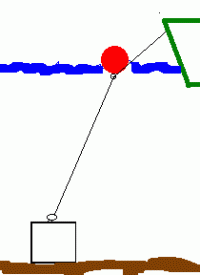hi everyone, i was looking at a pic of one of the ericsons docked . the anchor line apparently had a large basket ball floating in water near the boat....what is it for,,,sorry i've only been in this for 6 months,,,but i have learned a lot from all of you....it appears to be part of the anchor line? chip
You are using an out of date browser. It may not display this or other websites correctly.
You should upgrade or use an alternative browser.
You should upgrade or use an alternative browser.
Mooring Balls - a Good Thing!
Yeah, the mooring ball is attached to a chain which runs down to a heavy weight (usually a very heavy concrete block), auger device or submerged piling which acts as the anchor. The other end has a line coming off of it which you pick up and tie off to. In the image below, note how the owner has tied a bridle off to the ball - providing two points of load transfer. Note also the snubbers tied into the lines to reduce the amount of shock the mooring lines pass to the boat's deck cleats.
Mooring balls are common in areas where people keep their boats where there is no dock or pier - they are also very common in protected areas where the authorities do not want people using their anchors (like near coral reefs, or marine parks, etc). There is also a difference between public (like near beachs and parks) and private (like in front of waterfront homes) mooring balls. Public mooring balls are typically open - although a fee may be charged by a local ranger, etc - but the private balls are -privately owned- (as in the San Juan Islands, where you will not be greeted in a friendly manner if you tie up to someone else's ball).
Picking up (tying yourself off to) a mooring ball is not difficult - it just takes a bit of practice with a boat hook and slow approach. Be aware, however - that there are also buoys that look like anchor balls - that actually mark caution areas - such as sewage outfalls and obstructions. So, not everything that looks like an anchor ball may be one.
Anchorages (and mooring balls) are typically marked on your navigation charts with small anchors and other indicators, however this may vary by locale. You should should be well versed in all the aids to navigation however, and should consider purchasing a pilot's guide to your local navigation (has all the symbols, lights, etc for your area).
//sse
Yeah, the mooring ball is attached to a chain which runs down to a heavy weight (usually a very heavy concrete block), auger device or submerged piling which acts as the anchor. The other end has a line coming off of it which you pick up and tie off to. In the image below, note how the owner has tied a bridle off to the ball - providing two points of load transfer. Note also the snubbers tied into the lines to reduce the amount of shock the mooring lines pass to the boat's deck cleats.
Mooring balls are common in areas where people keep their boats where there is no dock or pier - they are also very common in protected areas where the authorities do not want people using their anchors (like near coral reefs, or marine parks, etc). There is also a difference between public (like near beachs and parks) and private (like in front of waterfront homes) mooring balls. Public mooring balls are typically open - although a fee may be charged by a local ranger, etc - but the private balls are -privately owned- (as in the San Juan Islands, where you will not be greeted in a friendly manner if you tie up to someone else's ball).
Picking up (tying yourself off to) a mooring ball is not difficult - it just takes a bit of practice with a boat hook and slow approach. Be aware, however - that there are also buoys that look like anchor balls - that actually mark caution areas - such as sewage outfalls and obstructions. So, not everything that looks like an anchor ball may be one.
Anchorages (and mooring balls) are typically marked on your navigation charts with small anchors and other indicators, however this may vary by locale. You should should be well versed in all the aids to navigation however, and should consider purchasing a pilot's guide to your local navigation (has all the symbols, lights, etc for your area).
//sse
Attachments
about the ball,
thank you very much..and especially for the pics...i would have never guessed it alone....i have learned so much in the last 6 months ....i will be working on freeing up a stuck halyard that raises the main sail....we havent raised the sails yet,,,,,,,we were rebuilding the electrical system first and refinishing the teak inside the ericson 25. hope to see how that goes real soon.....chip n angela
thank you very much..and especially for the pics...i would have never guessed it alone....i have learned so much in the last 6 months ....i will be working on freeing up a stuck halyard that raises the main sail....we havent raised the sails yet,,,,,,,we were rebuilding the electrical system first and refinishing the teak inside the ericson 25. hope to see how that goes real soon.....chip n angela
Back in the day, engine blocks, sometimes several of them all chained together were used here in RI and I suspect other places as mooring anchors. Around here the most common anchor is the 500lb mushroom. This is what my E38 is on but I wish it was a http://www.helixmooringsystems.com/ They are way better when the inevitable storm happens.
Never seen snubbers on mooring pendants. The way my club sets them up the mooring ball chains have plenty of scope, enough to swing in a 30ft circle at high tide. This chain and the ball itself cushions the shock as the whole thing straightens out. The boat next to me will pull the ball underwater when it surges in a 30+kt blow. Mine never does this. Mooring setups are an interesting topic and everyone has a different idea of whats best. Makes for interesting reading. RT
Never seen snubbers on mooring pendants. The way my club sets them up the mooring ball chains have plenty of scope, enough to swing in a 30ft circle at high tide. This chain and the ball itself cushions the shock as the whole thing straightens out. The boat next to me will pull the ball underwater when it surges in a 30+kt blow. Mine never does this. Mooring setups are an interesting topic and everyone has a different idea of whats best. Makes for interesting reading. RT
therapidone
Member III
Frank's right!
There's plenty of time to clean up when the weather is bad or the season is over...free the halyard & enjoy your boat!!
Of course, you should do whatever you think best...but a day on the water in your newly acquired boat will beat just about anything else.
Regards,
Ed
There's plenty of time to clean up when the weather is bad or the season is over...free the halyard & enjoy your boat!!

Of course, you should do whatever you think best...but a day on the water in your newly acquired boat will beat just about anything else.
Regards,
Ed

WhiteNoise
Member III
Refinishing teak or sailing? hmmmm
I did the same thing with my first boat and regretted doing too much work on my boat during the season rather than sailing. I vowed to never do that again. I'm with everyone else, go sailing. The projects will be there another day...and when you finish that one, there will be another. You will never be done.
Just be sure to get out as much as you can and enjoy this wonderful sport.
I did the same thing with my first boat and regretted doing too much work on my boat during the season rather than sailing. I vowed to never do that again. I'm with everyone else, go sailing. The projects will be there another day...and when you finish that one, there will be another. You will never be done.
Just be sure to get out as much as you can and enjoy this wonderful sport.



